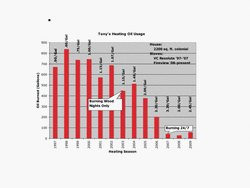Turfguy said:
What are the advantages of burning overnight and while at work during the day. My wife thinks I am crazy for burning when nobody is home or awake. I told her that it keeps the Natural Gas FHA furnace off while we are at work and overnight. Doesn't seem to be a compelling enough answer. Suggestion?
background:
We just bought and had our stove installed. I'm new to wood burning and she grew up with a fireplace in her home. Her parents put in a insert two months before our install and only burn in the evenings to take the chill out. I'm looking to save us some $. But everytime I buy wood she keeps making comments like "how much more do you need to keep getting." Only bought two cords worth of Logs to cut and split so far.
So, what happens when you just build a fire when you get home from work and an overnight fire then let it go out?
1. Regular furnace runs.
2. Furnace running takes dollars from your pocket.
3. Every time you have to light a fire in a cold stove, a certain amount of that heat goes into heating up the stove and the flue. This, in turn, causes you to use more wood for the time you are actually using the wood stove.
If you are burning 24 hours per day you don't have to heat up the cold stove. You can keep the house at a reasonably steady temperature with only moderate swings in temperature unless you also teach your wife how to load the stove and control the draft.
To me, one of the biggest benefits of burning 24/7 is that we can keep the house at a nice warm temperature. Rather than wearing sweaters or any heavy clothing, I typically wear only a t-shirt on top and the wife just wears.....a bit less than she normally would. I like it really warm so that when I come in from outdoor work I can get warm fast.
As for the wood and what you need on hand, you will find your first couple of years burning wood will mean you spend more time taking care of the wood. Then you will typically have a 2-3 year wood stash which will mean then you will work less because you only have to replace what you burned. You also will burn less wood because the wood is good and dry and it just will not take as much wood to get the heat you require. You also won't spend as much time cleaning that chimney because the dry wood will not give you the creosote problems that green wood will give.
All this and we haven't even considered the environment!
In my book, it is hard to beat burning wood 24/7. In fact, we have no other source of heat and we get along just fine. Even in our "senior" years we don't have to work all that hard to put up a year's supply of wood. Actually we find it gives us some needed exercise exactly when we need it most; during the cold months.
Happy heating to all.



